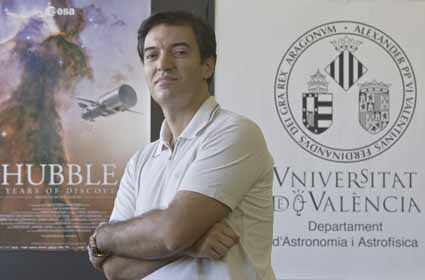
Conference on gamma ray bursts and their relationship with Relativity, today in La Nau in the Gravitation Congress
The main aim of this conference, which will take place in the Aula Magna of La Nau at 19:30, is to demonstrate that the phenomena with the most energetic power within the earth, gamma ray bursts, have a relativist nature.
In this sense, during the conference, researcher Aloy will explain that the radiation we can observe can only be seen because of the gigantic bursts produced to the expansion to speeds extraordinarily close to those of plasma light whose total mass is close to that of the Earth. Hence, “the radiation we receive is highly focused and incredibly reinforced’, indicates Aloy. These cinematic effects, as the speaker highlights, need of Einstein’s Spatial Theory of Relativity in order to be explained.
Endless power generators
But, in order to accumulate that quantity of power it is necessary, as Aloy will explain in his conference today, that a black hole if formed as a consequence of the collapse of the nucleus of a star much more massive than the sun. In order to understand the black hole’s formation process it is necessary, again, to go back to the relativist description of the gravitational field and, hence, to the General Theory of Relativity. In addition, and as remarked by Aloy ‘understanding how nature produces these phenomena is a first step in order to tray to reproduce power generators which would be basically endless’.
Miguel Angel Aloy is doctor in Theoretical Physics by the University of Valencia. Between 2000 and 2005 he did a post-doctoral stay in the Institute Plank für Astrophysik de Garching (MPA) in Germany. Among other contracts and helps, Aloy obtained one Marie Curie individual scholarship within the 6th frame programme of the European Union as well as a contract as researcher of excellence within the program Ramon y Cajal of the MICINN. Its researching trajectory has had positive evaluation of the different national and international organisms. Currently, he is professor of the Astronomy and Astrophysics Department of the University of Valencia being the numeric relativist hydrodynamics its main line of research, a field to which he has contributed both in methodological aspects and astrophysical applications. Currently, he leads the research group Computer Aided Mideling of Astrophysical Plasma (CAMAP), funded by the European Research Council.
Over 100 astrophysics meet at the congress of the Spanish Gravitational Society
This conference takes place in the frame of the international conference that is yearly organized by the Spanish Gravitational Society (SEGRE) and which takes place at the ADEIT until the end of the week. In this meeting, headed by Jose Antonio Font, professor of Astronomy and Astrophysics of the UniversitIn this meeting, headed by Jose Antonio Font, professor of Astronomy and Astrophysics of the University of Valencia a total of 114 astrophysicists were called in. The assistants, coming from the universities, institutes and research centers from different countries, are in its majority Spanish (41%), followed by Portuguese and Japanese (with a percentage of 10% each), French and German (with a 5% of assistants each). Additionally, there are researchers from other countries such as Mexico, USA, Iran, Brazil, Colombia, India or South Korea, among many.
The congress is centered on three research lines: relativist astrophysics, mathematic relativity and the interface between gravitation and the quantum theory.
More information: http://www.uv.es/ere2014/
Last update: 2 de september de 2014 08:54.
News release



















